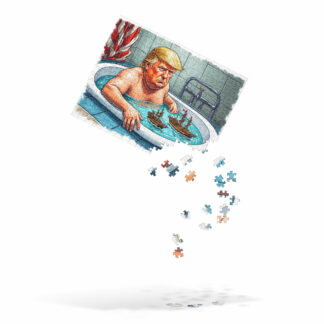The left and the right are both insufficient political concepts for today’s world, and political discourse reflects this inadequacy. It is, essentially, like trying to play a complex symphony with a kazoo: we are oversimplifying something deeply nuanced into something laughably inadequate. “Left” and “right” are not only outdated labels, as irrelevant as floppy disks in the modern era, but they also persist in dominating, distorting, and oversimplifying our understanding of political ideologies. These labels do more than just flatten nuance—they actively empower extremists and authoritarians by obscuring the contradictions and self-serving motivations that underpin their ideologies.
What if we had a better way to map political beliefs, one that could reveal not just balance but also imbalance, extremism, and authoritarian tendencies? Enter the Political Dynamics Spider (PDS)—a multidimensional chart that visualizes ideologies across five axes—and its cheeky satirical cousin, the Dictator Detector.
Why Both Left and Right Are Hopelessly Wrong
The “left-right” spectrum originated in the French Revolution, when political factions sat on literal sides of a room. “Left” represented revolutionaries, while “right” signaled loyalty to the monarchy. The spectrum made sense at the time, but it’s absurdly reductive in the modern context.
Take these examples:
- Franklin D. Roosevelt, who is often labeled a “leftist” for the New Deal, simultaneously consolidated federal power, thereby demonstrating strong hierarchical and centralized leadership tendencies.
- Donald Trump, on the one hand, brands himself as a “conservative,” yet, on the other hand, his protectionist tariffs and government spending noticeably lean toward socialist policies.
- Javier Milei, a libertarian firebrand, fights for radical economic freedom while clinging to deeply traditional cultural values.
These leaders don’t fit neatly into “left” or “right.” Instead, they reveal how these labels fail to address the multifaceted reality of political thought. That’s where the Political Dynamics Spider (PDS) comes in.
Introducing the Political Dynamics Spider (PDS)

The Political Dynamics Spider, or PDS, is a chart designed to map political ideologies across five critical axes. It offers a multidimensional view of beliefs, revealing the balance (or lack thereof) within an individual’s or leader’s philosophy. It’s also affectionately nicknamed the Dictator Detector for its sharp ability to expose and highlight authoritarian tendencies skillfully concealed beneath seemingly broad and inclusive ideologies.
The Five Axes of the PDS
- Governance: Who solves problems?
- Individual responsibility → Local/state governance → Federal authority → Global governance.
- Leadership: How are decisions made?
- Direct democracy → Republican oligarchy → Authoritarian rule.
- Economics: How is trade managed?
- Barter trade → Regulated capitalism → Command economy/socialism.
- Morality: What ethical principles guide decisions?
- Pragmatic/amoral → Universal ethical frameworks.
- Change Stance: How does society evolve?
- Ultra-conservatism → Incremental reform → Revolutionary change.

Each axis reflects a dimension of political thought, creating a unique “shape” that represents an ideology. Balanced philosophies appear smooth and rounded, while unbalanced ones become jagged, spiked, or overly concentrated.
Refining the PDS with the Scalloped Spectrum
While the PDS is an excellent starting point, we realized that extreme scores could create the illusion of breadth or balance. To combat this, we refined the model with the Scalloped Spectrum, which emphasizes extremism and imbalance:
Key Refinements:
- Pinched Extremes: Extreme values appear as sharp, angular spikes rather than full wedges, showcasing concentration rather than breadth.
- Highlighted Dips: Areas of neglect or imbalance appear as dips, exposing weaknesses or blind spots in ideology.
- Color Coding: Green for balance, yellow for moderate deviations, and red for dangerous extremes.
- Shape Metrics: Quantifiable measures like “spikiness” (number of sharp extremes) and “asymmetry” (imbalanced focus).
These refinements, therefore, make it easier to clearly distinguish between leaders who are well-rounded in their approach and those who, instead, consolidate power for self-serving purposes.
Analyzing Leaders with the PDS and Dictator Detector
Let’s see how the PDS and its satirical cousin, the Dictator Detector, expose the imbalances and contradictions of some famous leaders:
Donald Trump

- PDS Analysis: Trump’s chart features sharp spikes in hierarchy, governance, and leadership, with notable dips in morality and institutional reform. His economic policies—like tariffs and government subsidies—resemble protectionist socialism more than true conservatism.
- Dictator Detector Insight: Trump’s chart shows concentrated authority, with sharp spikes reflecting a philosophy centered on personal power rather than collective governance.


Franklin D. Roosevelt (FDR)

- PDS Analysis: FDR’s chart is smoother, with high scores in governance, institutional reform, and leadership. His New Deal policies leaned into federal authority but maintained a sense of balance.
- Dictator Detector Insight: FDR’s spikes in governance and reform reflect his progressive goals but stop short of authoritarian extremes. His chart showcases how centralized power can be used responsibly.


Adolf Hitler

- PDS Analysis: Hitler’s chart is a case study in extremism, with sharp spikes in governance, leadership, and hierarchy. His ideology concentrated power inward, creating the illusion of comprehensiveness while suppressing dissent.
- Dictator Detector Insight: Hitler’s jagged, spiked chart reveals his totalitarian approach, where every axis reinforces his authoritarian control.



Javier Milei

- PDS Analysis: Milei’s chart is narrow, with extreme spikes in economic libertarianism and minimal focus on governance or reform. His radical stance on dismantling state control leaves little room for compromise.
- Dictator Detector Insight: Milei’s concentrated focus on economics isolates him from broader governance concerns, making his ideology both radical and impractical.

How Authoritarianism Thrives in the Gaps
The PDS and Scalloped Spectrum expose how authoritarian leaders exploit public extremism:
- Fragmenting Opposition: By aligning with different factions on specific axes, extremists divide and weaken opposition.
- False Balance: Their high scores across axes create the illusion of broad appeal while hiding concentrated power.
- Centralized Authority: Sharp spikes in governance and leadership reveal their self-centered control.
The Dictator Detector nickname, therefore, highlights the comedic irony of these dynamics. In many cases, leaders who seem “strong” or “comprehensive” are, in reality, often just good at cleverly masking their extremism.
Readjust & Plot Your Perspective
The left-right spectrum is not just outdated—it’s dangerous. It obscures nuance, empowers authoritarian figures, and prevents meaningful discourse. The Political Dynamics Spider (PDS) offers a better framework, mapping ideologies across multiple dimensions to reveal balance, extremism, and hidden authoritarian tendencies.
The scalloped spectrum, in turn, refines this approach by exposing how self-centered ideologies strategically use concentrated power to exploit fragmented societies. Whether through Trump’s nationalist populism, Milei’s radical libertarianism, or Hitler’s totalitarianism, the PDS shows that extremism in any form leads to isolation—not progress.
It’s time to move beyond outdated labels and start evaluating leaders—and ourselves—on what really matters: balance, accountability, and the common good.
Because nothing is left on the left, and the right isn’t right either.















